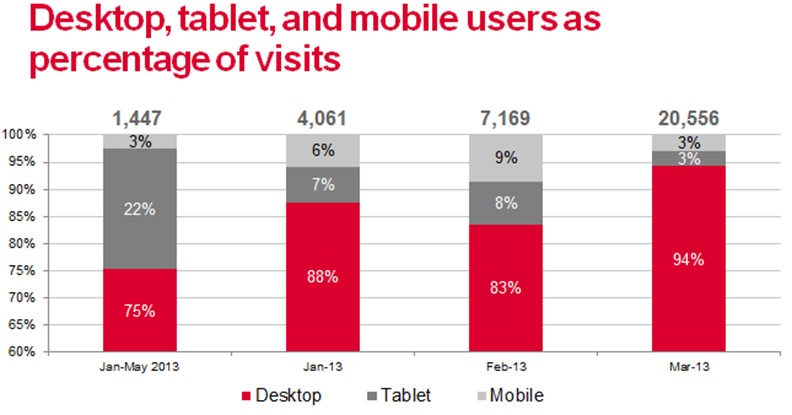A.N.A.L.Y.T.I.C.S corner - A Necessary Approach: Leveraging Your Target’s Insights Creatively & Strategically

Adrian Smith of Havas Life Metro shares his thoughts on how to interpret and integrate successful mobile campaigns in pharmaceutical marketing.
Build it and they will come –interpreting & integrating mobile campaigns successfully
As a pharma marketer, you may hear industry experts speak about mobile communications and the potential value it offers to customers. However, in most cases, your customers may not represent the majority profile of customers that mobile experts intend for you to influence. In fact, the desire is to build the most optimal marketing programs for healthcare professionals (HCPs) and patients that work within a given therapeutic category. Mobile adoption and usage varies by specialty, as well as patients / consumers, and impacting them within the pharma space takes thoughtful consideration and a smart approach.
Interpreting mobile metrics and quantifying the mobile business opportunity:
Justifying the additional investment in mobile to effectively reach healthcare professionals and patient audiences may appear difficult when making a business case or rationalize. The analytics report may not reveal a business rationale to change the status quo, leading one to believe that a particular audience (HCP or patient) has not fully adopted mobile centricity or may show a lack of mobile interaction.
Example A below shows Desktop, Tablet and Mobile users as a percentage of visits to a website. At first glance, it appears that Mobile engagement represents an insignificant amount of activity from Jan-May 2013. However, mobile activity (Tablet + Mobile) represents 25% of overall engagement.
Example A

Additionally, it's best to analyze how the impact of mobile metrics coincides with the investment in campaign optimizations and/or specific display and traffic driving programs to a website. Rationale: most campaigns (ie Google Display Networks, banner ad campaigns) are mobile responsive and attract high mobile usage according to healthcare professional adoption, as well as the types of messaging being delivered (ie educational vs specific calls to actions that may not require a longer educational content consumption). Often, Desktop usage patterns may coincide with the user consuming larger, educational pieces of content versus Mobile usage patterns that may reveal specific, directed content (ie dosing guidance, treatment specific information designed for the HCP and patient to discuss at time of treatment initiation).
Implementing a thoughtful plan of action:
1. Determine where your brand fits within the mobile landscape by assessing the competitive space and understanding specific use cases for mobile channels. For example, physicians are more likely to go on their mobile phone/tablet to check out medication key facts during and between patient visits.
2. Hold your advertising partners accountable for integrating mobile into your overall business plans. Make them provide rationale for the need to increase mobile spending, allowing you to make the smart investments over time to further build out your mobile portfolio as the analytics dictate.
3. Make investment decisions based on your target audiences' mobile adoption and efforts to maximize share of voice versus competition. Consider the following definitions to support mobile investment decisions:
a. Mobile Friendly (minimal investment): A mobile-friendly site is a website which content is rendered in a manner that is easily readable for mobile devices, such as smart phones and tablet devices. That said, it must include similar features found on a standard website, such as navigation, search options, and share functions.
b. Mobile Optimized (mid-level investment): A mobile optimized website is a website that is optimized for mobile devices. Meaning, it has been designed and formatted specifically to read and navigate easily on the small screens of mobile devices. Some features of mobile optimized websites: smaller, less detailed text blocks with focus on key points, larger navigation buttons, fewer graphics and may include phone numbers that start a call when clicked.
c. Mobile Responsive (higher investment): Responsive design is an approach to web page creation that makes use of flexible layouts, flexible images and cascading style sheet media queries. The goal of responsive design is to build web pages that detect the visitor's screen size and orientation and change the layout accordingly to deliver the same depth and detail of content regardless of the device used. An example of a mobile responsive site is www.actemra.com [or, for several examples, visit www.mediaqueri.es]
In today's promotional landscape, maximizing all your opportunities for enhanced communication means examining the optimal use of mobile formats. No matter how you decide to approach it, you should strongly consider what mobile communication means for your clients and their brands.
About the author:
Adrian has worked within the pharmaceutical/biotech marketing and advertising industry as a lead digital strategist and business development expert for 17 years. His expertise spans across all digital channels to support not only Marketing, but Marketing partners (Sales, Innovation, Managed Markets, Corporate) in creating a holistic approach. He aims to adopt a creative approach in building strategies that serve and empower marketers to keep their brands on the right path and has worked with the following companies to name a few: Eli Lilly, Genzyme, Sanofi-Aventis, Forest, BMS, GSK, Merck, Pfizer, Sunovion, Lundbeck, Boehringer-Ingelheim, Otsuka, Novartis, Genentech, Purdue, GE Healthcare, Mylan, Celgene, West-Ward, Ironwood, TAP, Takeda, Abbott, Proventy's
Closing thought: Please share how you use analytics to build new business.




